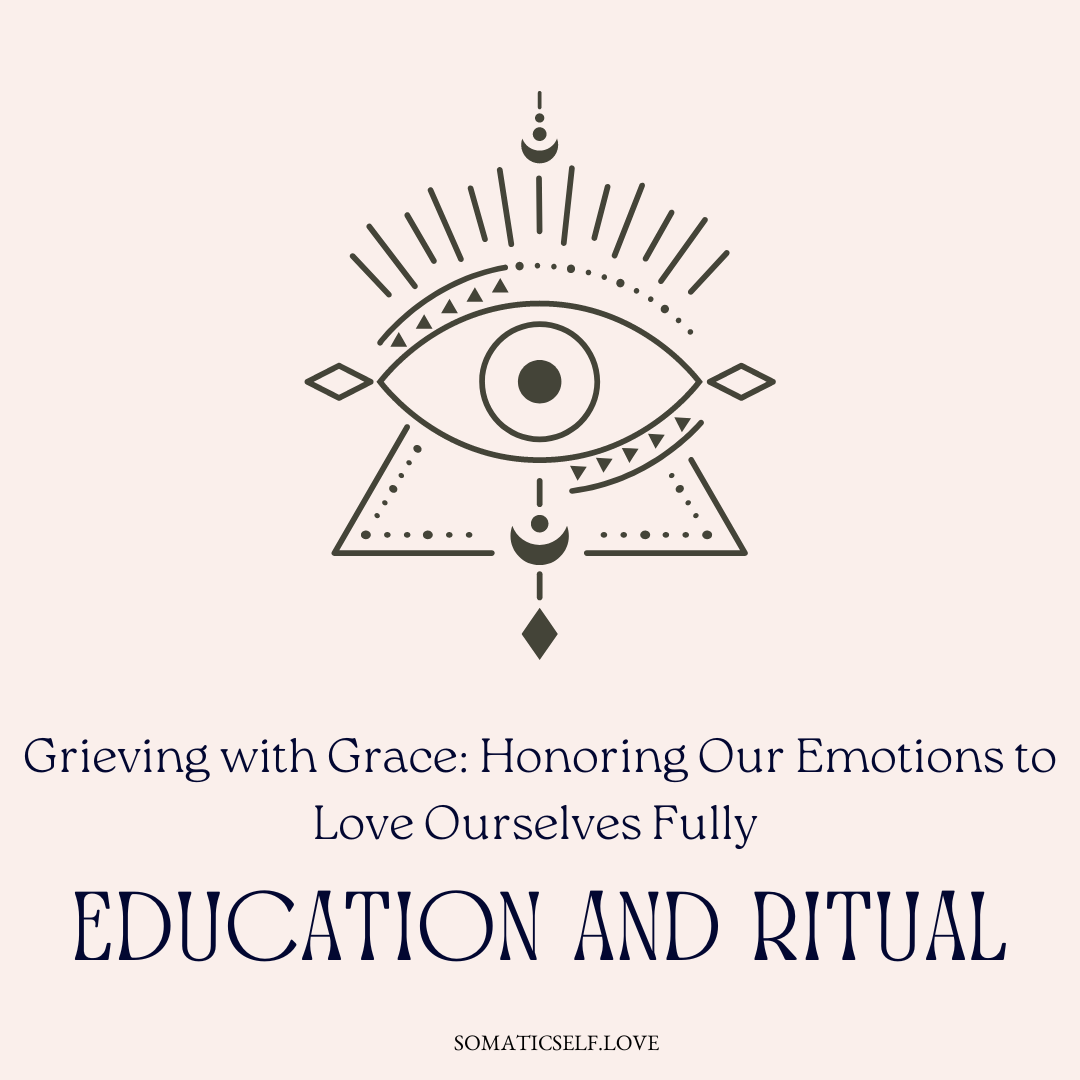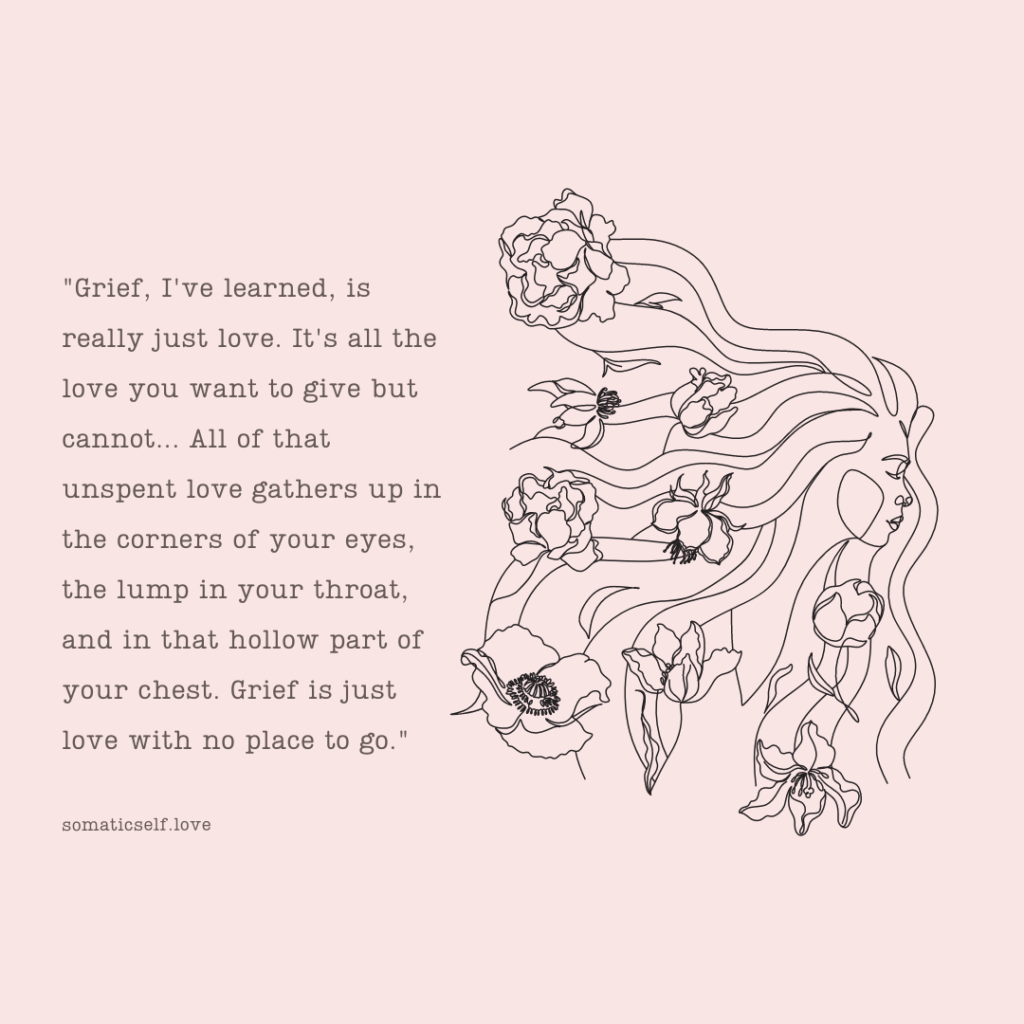Grieving with Grace: Honoring Our Emotions to Love Ourselves Fully and Feel Love Alive in the Body

Grief is a profound and deeply personal journey that can invite us into a space of deep self-understanding and compassion. In this journey, we can learn how to grieve gracefully, respecting our feelings so that we can fully love ourselves and experience the life of love in our bodies.
Grief can feel overwhelming, but it’s important to remember that it’s a natural response to loss. It isn’t something to be hurried or brushed aside but rather something to be acknowledged and honored. Our emotions are a fundamental part of who we are.
When we allow ourselves to feel our grief fully, we open the door to genuine self-love and acceptance. By learning to listen to our bodies and honor our emotions, we can experience love not just as an abstract concept but as a living, breathing entity within us. This is the essence of somatic self-love: feeling love alive in the body.
Embarking on a journey of grief and somatic self-love requires a willingness to navigate through the complexities of human emotions.
Grief is Not A Negative
Grief, often deemed as a negative emotion, is, in fact, an inherent part of our existence. It is a testament to the depth of our ability to love, care, and form meaningful connections. However, societal constructs often stigmatize grief, leading to its repression or avoidance. It is crucial to challenge such constructs, to allow ourselves to grieve with grace, and to acknowledge the transformative power of grief.
Understanding Grief
Grief is not a pathological condition to be eliminated but a normal response to loss. It is an intense emotional process that demands time, patience, and understanding. The prevailing norms often drive individuals to suppress their grief, to maintain a facade of strength and resilience. However, such suppression merely compounds the grief, distorting it into a more chronic form that can manifest in numerous physical and psychological ailments.
In the words of renowned psychiatrist and grief specialist Dr. Elisabeth Kübler-Ross, “The most beautiful people we have known are those who have known defeat, known suffering, known struggle, known loss, and have found their way out of the depths.”
This quote highlights the transformative power of grief. Through grief, we come face-to-face with our vulnerabilities, which opens the path to self-discovery and growth.
Embracing Somatic Self-Love
In the face of grief, somatic self-love emerges as an empowering process that enables us to reconnect with our emotions and bodies. This process involves acknowledging and feeling our emotions deeply instead of numbing or distancing ourselves from them. It is about embracing our grief, letting it move through us, and thus, allowing it to heal us. Such a process, though challenging, fosters an enhanced sense of self-awareness and self-love.

Somatic self-love is not merely about self-care routines or pampering oneself. It is about delving deeper into our physicality to feel love alive in our bodies. It involves recognizing our body as a vessel for experiencing and processing our emotions. By tuning into our bodies, we can ground ourselves in the present and navigate the tumultuous waters of grief with greater ease and resilience.
A Path of Vulnerability
The somatic self-love journey does not promise an easy fix to the pain and suffering caused by grief. Instead, it beckons us to a path of authenticity, vulnerability, and courage.
It invites us to honor our emotions, to feel them in their entirety, and in the process, cultivate a profound love for ourselves. The road may be riddled with challenges, but the destination is a holistic healing and growth that transcend the barriers of the physical and the psychological.
Grief can be a portal into feeling more love alive in our bodies for ourselves and each other as an emotional response to loss—a deeply human experience that universally binds us.
Somatic Self-Love: An Essential Companion to Grief
Somatic self-love refers to a profound understanding and acceptance of our body, recognizing and honoring its needs, and fostering a nurturing relationship.
It focuses on the body’s wisdom and innate capacity for healing. In the context of grief, somatic self-love creates space to feel pain deeply, allowing it to move and evolve rather than suppressing or sidestepping it.
“Grief, I’ve learned, is really just love. It’s all the love you want to give but cannot… All of that unspent love gathers up in the corners of your eyes, the lump in your throat, and in that hollow part of your chest. Grief is just love with no place to go.”
—Jamie Anderson
Anderson’s poignant words shed light on the complex interplay between grief and love. By allowing ourselves to feel the weight of our grief, we inadvertently unlock a reservoir of love and empathy within us. This emotional awakening is transformative, not only for our understanding of ourselves but also for our relationships with others.
Grief and its Embodiment
The embodiment of grief refers to the physical manifestation of our emotional suffering. It is feeling the tightness in the chest, the heaviness in the limbs, the knot in the stomach. These somatic experiences are often dismissed as merely symptomatic of emotional distress. However, they hold a deeper significance. These sensations serve as tangible proof of our emotional reality, validating our grief and, ultimately, our humanity. By acknowledging these physical sensations, we practice somatic self-love, fostering a deeper connection with our bodies and our emotions.
Moving through Grief with Somatic Self-Love
Allowing grief to move through us involves a conscious decision to sit with our pain, to feel it in its entirety, and to let it naturally ebb and flow. This decision requires courage and honesty, as well as a steadfast commitment to self-love and self-care. It is by truly feeling our grief, by allowing it to manifest somatically, that we can begin the healing process. This healing is not about forgetting or moving on but about understanding, accepting, and integrating our loss into our lives. Consequently, this process deepens our capacity for self-love and by extension, our capacity to love others.
Moving Through Grief with Somatic Self-Love Ritual
What You’ll Need:
- A quiet, comfortable space
- A notebook and a pen
- Comforting items (like a favorite blanket, a soft pillow, a beloved photo)
- A timer
The Ritual:
- Preparation: Find a quiet, comfortable space where you won’t be interrupted. This could be a cozy corner in your home, a sunny spot in your garden, or even a peaceful park. Bring along your notebook, pen, comforting items, and a timer.
- Grounding: Sit or lie down in a comfortable position. Close your eyes and take deep, slow breaths. Feel the air fill your lungs and then slowly leave your body. Listen to the sound of your breath and let it anchor you in the present moment.
- Body Scanning: Begin at the top of your head and slowly scan down your body. Notice any physical sensations – tension, heaviness, numbness, warmth, tingling. Don’t judge or try to change these sensations. Simply notice them.
- Emotional Mapping: Now, turn your attention to your emotions. Where in your body do you feel your grief? It could be a tightness in your chest, a pit in your stomach, a heaviness in your heart. Again, don’t judge or try to change these feelings. Simply notice them.
- Journaling: Open your eyes and take up your pen and notebook. Write about what you’ve noticed, both physically and emotionally. Let your words flow without censoring or editing them.
- Somatic Expression: Return to the physical location of your grief. Allow yourself to express this grief somatically. You might want to cry, scream into a pillow, or simply breathe into the sensation. Do whatever feels right for you, ensuring you’re not causing harm to yourself or others.
- Self-Compassion Break: Set your timer for 5 minutes. During this time, place your hands over your heart or another comforting place on your body. Speak to yourself as you would a dear friend. You might say, “This is a moment of suffering. It’s okay to feel this pain. I’m here for you.”
- Integration: After your self-compassion break, take a few moments to sit quietly and breathe. Picture your grief integrating into you, not as a destructive force, but as a part of your life experience that deepens your capacity for empathy, compassion, and love.
- Closing: Finally, wrap up your ritual by writing a few lines in your journal about your experience and any insights you’ve gained. This will help consolidate your experience and highlight your journey through grief.
Remember, everyone grieves differently, and this ritual is just a guideline. Feel free to modify it to suit your needs. The most important thing is to approach your grief with kindness, honesty, and patience.
Safe Support and Tending
As you travel through your journey of grief, remember that you don’t have to do it alone. Grief can be overwhelming at times, and having a dedicated, experienced guide can make all the difference.
If you’re feeling the weight of grief, and you’re curious about how breathwork can help you navigate your feelings, I invite you to take a courageous step forward and sign up for a private breathwork session.
In these private sessions, we’ll create a safe and supportive space for you to explore your grief. We’ll use targeted breathing techniques tailored to you, helping you connect with your emotions and your body. Together, we’ll work towards releasing stored emotions, expressing your grief, and fostering self-love and compassion.
Are you ready to let breathwork be a part of your healing journey? You don’t need any prior experience, just the willingness to explore and heal.
Click here to book a private breathwork session
Take your time, breathe, and remember: you are not alone in your grief. You have the strength within to move through this, and I’m here to support you when you’re ready.